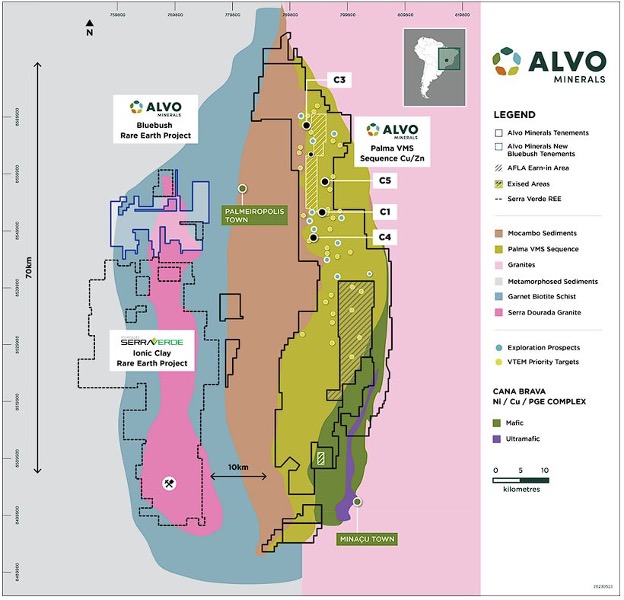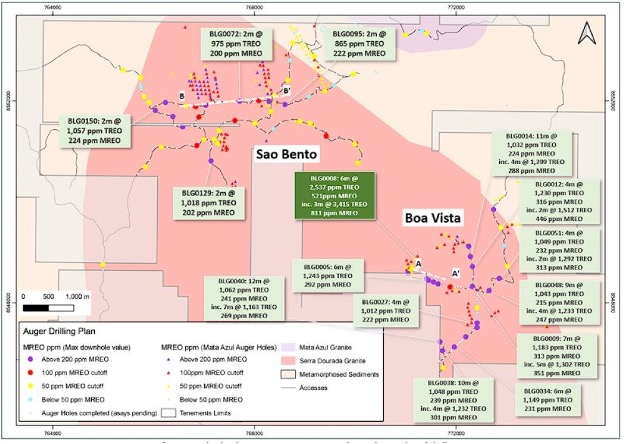Another Serra Verde? Alvo hits thick, high grade REEs next to the only ex-China tier 1 ionic clay mine development in the world

Pic via Getty Images.
- Auger drilling at Bluebush has shown up to 3,415ppm TREO from surface
- Bluebush adjacent to and in the same geological setting as tier-one Serra Verde project, the only ionic clay REE project currently being commissioned outside of China
- Exploration is accelerating with further results due in the coming weeks
Rare earths explorer Alvo Minerals is starting to see signs it may have another Serra Verde on its hands after auger drill results returned exceptionally high-grade rare earth hits from its Bluebush REE project in Brazil.
The Alvo Minerals (ASX:ARV) share price caught a rocket when the acquisition of the Bluebush rare earth project was announced in June, where the explorer highlighted the potential for the asset to uncover an ionic clay deposit similar to the neighbouring world class Serra Verde project.
Importantly for Alvo, Bluebush is right next door – and in the same rocks – as the world-class Serra Verde project, which is the only ionic clay rare earth project under construction outside China. Alvo is currently running preliminary testing for ionic clay hosted mineralisation at Bluebush, with results expected in the coming weeks.
Alvo’s latest auger drilling has returned the highest TREO results received to date, with exceptional levels of Dysprosium (Dy) and Terbium (Tb), which are the highest value MREOs.
These early signs point to Bluebush having some of the hallmarks of another Serra Verde, which has an MRE of 911Mt @ 1,200ppm TREO and an ore reserve of 350Mt @ 1,500ppm TREO.
To put those grades in perspective, it’s widely accepted that China’s (including owned deposits in Myanmar) ionic clay REE deposits average ~600ppm – making Serra Verde, Caldeira and potentially Bluebush, three of the highest-grade projects of their kind in the world.
The proof is in the drilling
A maiden drill program at Alvo Minerals’ (ASX:ARV) Bluebush REE project is showing exceptionally high-grade total rare earth oxides (TREO) up to an eye-watering 3,415 parts per million (ppm).

All up, 210 auger drill holes (covering 1,669m) were drilled at Bluebush, sampling the near-surface ionic clays at depths where rare earth mineralisation are typically located.
77 samples have been returned so far and have exhibited exceptional dysprosium and terbium levels, including a stellar hit of 6m @ 2,537ppm TREO, including 3m @ 3,415ppm TREO (24% MREO) from surface and ending in mineralisation at the Boa Vista and Sao Bento prospects.
Other outstanding hits from drilling include:
- 6m @ 1,243ppm TREO (23% MREO) to end of hole (EOH) from 8m
- 7m @ 1,183ppm TREO (26% MREO) EOH from 3m
- 4m @ 1,230ppm TREO (26% MREO) EOH from 2m
- 2m @ 1,512ppm TREO (29% MREO) EOH from 4m

These results are an indication that Bluebush is looking more and more like another potential Serra Verde,” Alvo MD Rob Smakman says.
“In our opinion, Brazil really is emerging as the most important ex-China location for Ionic-Clay hosted rare earth projects, especially the Magnet REEs, and the early results indicate that Bluebush will be an important project in this space.”
Next steps
Smakman says Alvo plans on focusing on the areas with the higher-grades of the higher-value MREOs, as these are the most important aspect of all REE projects.
Alvo will use Utilise a Loupe Portable Electromagnetic survey system to map the near surface conductivity of the project area to gauge the thickness and extent of the saprolite/clay horizons in order to prioritise future drill targets.
The strategy of this mapping is to map the thickness and extent of saprolite/clay horizons to prioritise ongoing exploration.
“There is fantastic potential at Boa Vista, and we will now start a more systematic approach to the auger drilling, whilst we wait for more drill results from the northern Sao Bento prospects,” Smakman says.
“We are also planning some diamond drilling to better test the depth-extent of the saprolite. Given most of the high-grade mineralisation ended at the bottom of the holes, we really don’t know how deep the mineralisation goes at Boa Vista.
“Exploration is continuing across Bluebush with a soil sampling campaign, handheld auger drilling and the initiation of the Loupe geophysical surveys and we are of course waiting for the all-important results for the ionic-clay tests, expected within weeks.”
This article was developed in collaboration with Alvo Minerals, a Stockhead advertiser at the time of publishing.
This article does not constitute financial product advice. You should consider obtaining independent advice before making any financial decisions.
Related Topics

UNLOCK INSIGHTS
Discover the untold stories of emerging ASX stocks.
Daily news and expert analysis, it's free to subscribe.
By proceeding, you confirm you understand that we handle personal information in accordance with our Privacy Policy.








